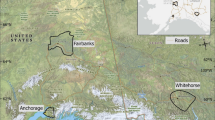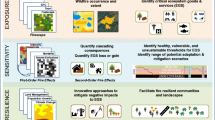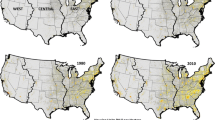Abstract
We examined landscape exposure to wildfire potential, insects and disease risk, and urban and exurban development for the conterminous US (CONUS). Our analysis relied on spatial data used by federal agencies to evaluate these stressors nationally. We combined stressor data with a climate change exposure metric to identify when temperature is likely to depart from historical conditions and become “unprecedented.” We used a neighborhood analysis procedure based on key stressor thresholds within a geographic information system to examine the extent of landscape exposure to our set of individual and coinciding stressors. Our focus is on identifying large contiguous areas of stress exposure which would be of national concern to identify potential locations most vulnerable to resulting ecological and social disruption. The arrival of record-setting temperatures may be both rapid and widespread within the CONUS under RCP8.5. By 2060, 91 % of the CONUS could depart from the climate of the last century. While much of the CONUS may be impacted by at least one of the landscape stressors we examined, multiple coinciding stressors occurred for less than 9 % of the CONUS. The two most prevalent coinciding stressors were (1) wildfire potential combined with insects and disease risk, and (2) climate departure combined with urban and exurban development. Combined exposure to three or more stressors was rare, but we did identify several localized high-population areas that may be vulnerable to future change. Additional assessment and research for these areas may provide early and proactive approaches to mitigating multiple stressor exposure.


Similar content being viewed by others
References
Aber JA, Neilson RP, McNulty S, Lenihan JM, Bachelet D, Drapek RJ (2001) Forest processes and global environmental change: predicting the effects of individual and multiple stressors. Bioscience 51:735–751. doi:10.1641/0006-3568(2001)051[0735:FPAGEC]2.0.CO;2
Ager AA, Finney MA, Kerns BK, Maffei H (2007) Modeling wildfire risk to northern spotted owl (Strix occidentalis caurina) habitat in Central Oregon, USA. For Ecol Manag 246:45–56. doi:10.1016/j.foreco.2007.03.070
Ager AA, Day MA, McHugh CW, Short K, Gilbertson-Day J, Finney MA, Calkin DE (2014) Wildfire exposure and fuel management on western US national forests. J Environ Manag 145:54–70. doi:10.1016/j.jenvman.2014.05.035
Agrawal A, Cashore B, Hardin R, Shepard G, Benson C, Miller D (2013) Economic contributions of forests. Background paper prepared for the United Nations Forum on Forests, April 8–19, Istanbul
Allen CD (2007) Interactions across spatial scales among forest dieback, fire, and erosion in northern New Mexico landscapes. Ecosystems 10:797–808. doi:10.1007/s10021-007-9057-4
Allen CD, Macalady AK, Chenchouni H, Bachelet D, McDowell N, Vennetier M, Kitzberger T, Rigling A, Breshears DD, Hogg EHT, Gonzales P, Fensham R, Zhang Z, Castro J, Demidova N, Lim J-H, Allard G, Running SW, Semerci A, Cobb N (2009) A global overview of drought and heat-induced tree mortality reveals emerging climate change risks for forests. For Ecol Manag 259:660–684
Ayres M, Hicke JA, Kerns BK, McKenzie D, Littell JS, Band LE, Luce CH, Weed AA (2014) Effects of climate change on disturbance regimes. In: Peterson DL, Vose JM, Patel-Weynand T (eds) Climate change and United States Forests. Springer, Dordrecht, pp 55–92
Bar-Massada A, Stewart SI, Hammer RB, Mockrin MH, Radeloff VC (2013) Using structure location as a basis for mapping the wildland urban interface. J Environ Manag 128:540–547. doi:10.1016/j.jenvman.2013.06.021
Bedel AP, Mote TL, Goodrick SL (2013) Climate change and associated fire potential for the south-eastern United States in the 21st century. Int J Wildland Fire 22:1034–1043. doi:10.1071/Wf13018
Bigler C, Kulakowski D, Veblen TT (2005) Multiple disturbance interactions and drought influence fire severity in rocky mountain subalpine forests. Ecology 86:3018–3029. doi:10.1890/05-0011
Binford MW, Kolata AL, Brenner M, Janusek JW, Seddon MT, Abbott M, Curtis JH (1997) Climate variation and the rise and fall of an Andean civilization. Quat Res 47:235–248. doi:10.1006/qres.1997.1882
Bonan GB (2008) Forests and climate change: forcings, feedbacks, and the climate benefits of forests. Science 320:1444–1449. doi:10.1126/science.1155121
Bowman DMJS, Johnston FH (2005) Wildfire smoke, management, and human health. EcoHealth 2:76–80. doi:10.1007/s10393-004-0149-8
Buma B, Wessman CA (2011) Disturbance interactions can impact resilience mechanisms of forests. Ecosphere 2:art64. doi:10.1890/ES11-00038.1
Certini G (2005) Effects of fire on properties of forest soils: a review. Oecologia 143:1–10. doi:10.1007/s00442-004-1788-8
Collins S, Larry E (2007) Caring for our natural areas: an ecosystem services perspective. USDA Forest Service, Pacific Northwest Research Station, Portland
Dale VH, Joyce LA, McNulty S, Neilson RP, Ayres MP, Flannigan MD, Hanson PJ, Irland LC, Lugo AE, Peterson CJ, Simberloff D, Swanson FJ, Stocks BJ, Wotton BM (2001) Climate change and forest disturbances. Bioscience 51:723–734. doi:10.1641/0006-3568(2001)051[0723:CCAFD]2.0.CO;2
Daly C, Neilson RP, Phillips DL (1994) A statistical-topographic model for mapping climatological precipitation over mountainous terrain. J Appl Meteorol 33:140–158. doi:10.1175/1520-0450(1994)033<0140%3AASTMFM>2.0.CO
D’Antonio CM, Vitousek PM (1992) Biological invasions by exotic grasses, the grass/fire cycle, and global change. Annu Rev Ecol Syst 23:63–87. doi:10.1146/annurev.es.23.110192.000431
Dillon G, Menakis J, Fay F (2012) Wildland Fire Potential (WFP) for the conterminous United States, v2012. USDA Forest Service, Rocky Mountain Research Station. http://www.firelab.org/project/wildland-fire-potential. Accessed 30 October 2013
FAO (2013) Climate change guidelines for forest managers. FAO Forestry Paper No. 172. Food and Agriculture Organization of the United Nations, Rome
FHTET (2012) 2012 National Insect & Disease Risk Map. USDA Forest Service, Forest Health Technology Enterprise Team. http://www.fs.fed.us/foresthealth/technology/nidrm2012.shtml. Accessed 30 October 2013
Finney MA, McHugh CW, Grenfell IC, Riley KL, Short KC (2011) A simulation of probabilistic wildfire components for the continental United States. Stoch Env Res Ris A 25:973–1000. doi:10.1007/s00477-011-0462-z
GAO (2005) Protecting structures and improving communication during wildland fires: a report to congressional requesters. GAO-05-380. GAO, Washington
Gavier-Pizarro GI, Radeloff VC, Stewart SI, Huebner CD, Keuler NS (2010) Housing is positively associated with invasive exotic plant species richness in New England, USA. Ecol Appl 20:1913–1925. doi:10.1890/09-2168.1
Groffman P, Baron J, Blett T, Gold A, Goodman I, Gunderson L, Levinson B, Palmer M, Paerl H, Peterson G, Poff N, Rejeski D, Reynolds J, Turner M, Weathers K, Wiens J (2006) Ecological thresholds: the key to successful environmental management or an important concept with no practical application? Ecosystems 9:1–13. doi:10.1007/s10021-003-0142-z
Harrison PA, Holman IP, Cojocaru G, Kok K, Kontogianni A, Metzger MJ, Gramberger M (2013) Combining qualitative and quantitative understanding for exploring cross-sectoral climate change impacts, adaptation and vulnerability in Europe. Reg Environ Change 13:761–780. doi:10.1007/s10113-012-0361-y
Hastings A (2010) Timescales, dynamics, and ecological understanding. Ecology 91:3471–3480. doi:10.1016/j.tree.2003.09.007
He HS, Mladenoff DJ (1999) Spatially explicit and stochastic simulation of forest-landscape fire disturbance and succession. Ecology 80:81–99. doi:10.1890/0012-9658(1999)080[0081:SEASSO]2.0.CO;2
Hesseln H, Loomis JB, Gonzalez-Caban A, Alexander S (2003) Wildfire effects on hiking and biking demand in New Mexico: a travel cost study. J Environ Manag 69:359–368. doi:10.1016/j.jenvman.2003.09.012
Hicke JA, Johnson MC, Jane LHD, Preisler HK (2012) Effects of bark beetle-caused tree mortality on wildfire. For Ecol Manag 271:81–90. doi:10.1016/j.foreco.2012.02.005
Hoffman C, Morgan P, Mell W, Parsons R, Strand EK, Cook S (2012) Numerical simulation of crown fire hazard immediately after bark beetle-caused mortality in lodgepole pine forests. For Sci 58:178–188. doi:10.5849/forsci.10-137
IPCC (2007) Climate Change 2007: Synthesis Report. In: Pachauri R, Reisinger A (eds) Contribution of working groups I, II and III to the Fourth assessment report of the intergovernmental panel on climate change. IPCC, Geneva, p 104
Jenkins MJ, Hebertson E, Page W, Jorgensen CA (2008) Bark beetles, fuels, fires and implications for forest management in the Intermountain West. For Ecol Manag 254:16–34. doi:10.1016/j.foreco.2007.09.045
Kline JD, Kerns BK, Day M, Hammer RB (2013) Mapping multiple forest threats in the northwestern US. J Forest 111:206–213. doi:10.5849/jof.12-099
Knutti R, Furrer R, Tebaldi C, Cermak J, Meehl GA (2010) Challenges in combining projections from multiple climate models. J Climate 23:2739–2758. doi:10.1175/2009JCLI3361.1
Krist FJ Jr, Ellenwood JR, Woods ME, McMahan AJ, Cowardin JP, Ryerson DE, Sapio FJ, Zweifler MO, Romero SA (2014) 2013–2027 National Insect and Disease Forest Risk Assessment. FHTET-14-01. USDA Forest Service, Forest Health Technology Enterprise Team
Kurz WA, Dymond CC, Stinson G, Rampley GJ, Neilson ET, Carroll AL, Ebata T, Safranyik L (2008) Mountain pine beetle and forest carbon feedback to climate change. Nature 452:987–990. doi:10.1038/nature06777
Landis WG (2005) Regional scale ecological risk assessment: using the relative risk model. CRC Press, Boca Raton
Landis WG, Wiegers J (2005) Introduction to the regional risk assessment using the relative risk model. In: Landis WG (ed) Regional Scale ecological risk assessment: using the relative risk model. CRC Press LLC, Boca Raton, pp 11–36
Logan JA, Régnière J, Powell JA (2003) Assessing the impacts of global warming on forest pest dynamics. Front Ecol Environ 1:130–137. doi:10.1890/1540-9295(2003)001[0130:ATIOGW]2.0.CO;2
Maestas JD, Knight RL, Gilgert WC (2001) Biodiversity and land-use change in the American Mountain West. Geogr Rev 91:509–524. doi:10.2307/3594738
McCullough DG, Werner RA, Neumann D (1998) Fire and insects in northern and boreal forest ecosystems of North America. Annu Rev Entomol 43:107–127. doi:10.1146/annurev.ento.43.1.107
McKenzie D, Peterson DL, Littell JJ (2009) Global warming and stress complexes in forests of western North America. In: Bytnerowicz A, Arbaugh M, Riebau A, Andersen C (eds) Wildland fires and air pollution developments in environmental science. Elsevier, Amstersdam, pp 319–338
Menakis JP, Cohen JD, Bradshaw L (2003) Mapping wildland fire risk to flammable structures for the conterminous United States. In: Galley KEM, Klinger RC, Sugihara NG (eds) Proceedings of the fire conference 2000: the first national congress on fire ecology, prevention and management Misc Pub No 13. Tall Timbers Research Station, Tallahassee, pp 41–49
Mendoza GA, Martins H (2006) Multi-criteria decision analysis in natural resource management: a critical review of methods and new modelling paradigms. For Ecol Manag 230:1–22. doi:10.1016/j.foreco.2006.03.023
Mercer DE, Prestemon JP (2005) Comparing production function models for wildfire risk analysis in the wildland-urban interface. Forest Policy Econ 7:782–795. doi:10.1016/j.forpol.2005.03.003
Metzger MJ, Schroter D (2006) Towards a spatially explicit and quantitative vulnerability assessment of environmental change in Europe. Reg Environ Change 6:201–216. doi:10.1007/s10113-006-0020-2
Metzger MJ, Schroter D, Leemans R, Cramer W (2008) A spatially explicit and quantitative vulnerability assessment of ecosystem service change in Europe. Reg Environ Change 8:91–107. doi:10.1007/s10113-008-0044-x
Millar CI, Stephenson NL, Stephens SL (2007) Climate change and forests of the future: managing in the face of uncertainty. Ecol Appl 17:2145–2151. doi:10.1890/06-1715.1
Mora C, Frazier AG, Longman RJ, Dacks RS, Walton MM, Tong EJ, Sanchez JJ, Kaiser LR, Stender YO, Anderson JM, Ambrosino CM, Fernandez-Silva I, Giuseffi LM, Giambelluca TW (2013) The projected timing of climate departure from recent variability. Nature 502:183–187. doi:10.1038/Nature12540
Moss RH, Edmonds JA, Hibbard KA, Manning MR, Rose SK, van Vuuren DP, Carter TR, Emori S, Kainuma M, Kram T, Meehl GA, Mitchell JFB, Nakicenovic N, Riahi K, Smith SJ, Stouffer RJ, Thomson AM, Weyant JP, Wilbanks TJ (2010) The next generation of scenarios for climate change research and assessment. Nature 463:747–756. doi:10.1038/Nature08823
O’Brien K, Leichenko R, Kelkar U, Venema H, Aandahl G, Tompkins H, Javed A, Bhadwal S, Barg S, Nygaard L, West J (2004) Mapping vulnerability to multiple stressors: climate change and globalization in India. Global Environ Chang 14:303–313. doi:10.1016/j.gloenvcha.2004.01.001
Paine RT, Tegner MJ, Johnson EA (1998) Compounded perturbations yield ecological surprises. Ecosystems 1:535–545. doi:10.1007/s100219900049
Patz JA, Campbell-Lendrum D, Holloway T, Foley JA (2005) Impact of regional climate change on human health. Nature 438:310–317. doi:10.1038/nature04188
Peterson DW, Kerns BK, Dodson EK (2014) Climate change effects on vegetation in the Pacific Northwest: a review and synthesis of the scientific literature and simulation model projections. Gen. Tech. Rep. PNW-GTR-900. USDA Forest Service, Pacific Northwest Research Station, Portland
Piontek F, Muller C, Pugh TAM, Clark DB, Deryng D, Elliott J, Gonzalez FDC, Florke M, Folberth C, Franssen W, Frieler K, Friend AD, Gosling SN, Hemming D, Khabarov N, Kim HJ, Lomas MR, Masaki Y, Mengel M, Morse A, Neumann K, Nishina K, Ostberg S, Pavlick R, Ruane AC, Schewe J, Schmid E, Stacke T, Tang QH, Tessler ZD, Tompkins AM, Warszawski L, Wisser D, Schellnhuber HJ (2014) Multisectoral climate impact hotspots in a warming world. Proc Natl Acad Sci USA 111:3233–3238. doi:10.1073/pnas.1222471110
Radeloff VC, Hagen AE, Voss PR, Field DR, Mladenoff DJ (2000) Exploring the spatial relationship between census and land-cover data. Soc Natur Resour 13:599–609. doi:10.1080/08941920050114646
Radeloff VC, Hammer RB, Stewart SI (2005a) Rural and suburban sprawl in the US Midwest from 1940 to 2000 and its relation to forest fragmentation. Conserv Biol 19:793–805. doi:10.1111/j.1523-1739.2005.00387.x
Radeloff VC, Hammer RB, Stewart SI, Fried JS, Holcomb SS, McKeefry JF (2005b) The wildland-urban interface in the United States. Ecol Appl 15:799–805. doi:10.1890/04-1413
Radeloff VC, Stewart SI, Hawbaker TJ, Gimmi U, Pidgeon AM, Flather CH, Hammer RB, Helmers DP (2010) Housing growth in and near United States protected areas limits their conservation value. Proc Natl Acad Sci USA 107:940–945. doi:10.1073/pnas.0911131107
Riahi K, Krey V, Rao S, Chirkov V, Fischer G, Kolp P, Kindermann G, Nakicenovic N, Rafai P (2011) RCP-8.5: exploring the consequence of high emission trajectories. Clim Change 109:33–57. doi:10.1007/s10584-011-0149-y
Romero-Lankao P, Smith JB, Davidson DJ, Diffenbaugh NS, Kinney PL, Kirshen P, Kovacs P, Villers-Ruiz L (2014) North America. In: Barros VR, Field CB, Dokken DJ, Mastrandrea MD, Mach KJ, Bilir TE, Chatterjee M, Ebi KL, Estrada YO, Genova RC, Girma B, Kissel ES, Levy AN, MacCracken S, Mastrandrea PR, White LL (eds) Climate change 2014: impacts, adaptation, and vulnerability part B: regional aspects contribution of working group II to the fifth assessment report of the intergovernmental panel on climate change. Cambridge University Press, Cambridge, pp 1439–1498
Rupp DE, Abatzoglou JT, Hegewisch KC, Mote PW (2013) Evaluation of CMIP5 20th century climate simulations for the Pacific Northwest USA. J Geophys Res-Atmos 118:10884–10906. doi:10.1002/Jgrd.50843
Sampson RN, Atkinson RD, Lewis JW (2000) Mapping wildfire hazards and risks. Food Products Press, New York
Schwilk DW, Knapp EE, Ferrenberg SM, Keeley JE, Caprio AC (2006) Tree mortality from fire and bark beetles following early and late season prescribed fires in a Sierra Nevada mixed-conifer forest. For Ecol Manag 232:36–45. doi:10.1016/j.foreco.2006.05.036
Shakesby RA, Doerr SH (2006) Wildfire as a hydrological and geomorphological agent. Earth-Sci Rev 74:269–307. doi:10.1016/j.earscirev.2005.10.006
Sheffield J, Barrett AP, Colle B, Fernando DN, Fu R, Geil KL, Hu Q, Kinter J, Kumar S, Langenbrunner B, Lombardo K, Long LN, Maloney E, Mariotti A, Meyerson JE, Mo KC, Neelin JD, Nigam S, Pan ZT, Ren T, Ruiz-Barradas A, Serra YL, Seth A, Thibeault JM, Stroeve JC, Yang Z, Yin L (2013) North American climate in CMIP5 experiments. Part I: evaluation of historical simulations of continental and regional climatology. J Climate 26:9209–9245. doi:10.1175/Jcli-D-12-00592.1
Smith WB, Miles PD, Perry CH, Pugh SA (2009) Forest resources of the United States, 2007. Gen. Tech. Rep. WO-78. USDA Forest Service, Washington Office, Washington
Smith P, Bustamante M, Ahammad H, Clark H, Dong H, Elsiddig EA, Haberl H, Harper R, House J, Jafari M, Masera O, Mbow C, Ravindranath NH, Rice CW, Robledo Abad C, Romanovskaya A, Sperling F, Tubiello F (2014) Agriculture, forestry and other land use (AFOLU). In: Edenhofer O, Pichs-Madruga R, Sokona Y, Farahani E, Kadner S, Seyboth K, Adler A, Baum I, Brunner S, Eickemeier P, Kriemann B, Savolainen J, Schlömer S, von Stechow C, Zwickel T, Minx JC (eds) Climate change 2014: mitigation of climate change contribution of working group III to the fifth assessment report of the intergovernmental panel on climate change. Cambridge University Press, Cambridge, pp 811–922
Spracklen DV, Mickley LJ, Logan JA, Hudman RC, Yevich R, Flannigan MD, Westerling AL (2009) Impacts of climate change from 2000 to 2050 on wildfire activity and carbonaceous aerosol concentrations in the western United States. J Geophys Res 114:D20301. doi:10.1029/2008JD010966
Stephens SL, Agee JK, Fule PZ, North MP, Romme WH, Swetnam TW, Turner MG (2013) Managing forests and fire in changing climates. Science 342:41–42. doi:10.1126/science.1240294
Taylor KE, Stouffer RJ, Meehl GA (2012) An overview of CMIP5 and the experimental design. Bull Am Meteorol Soc 93:485–498. doi:10.1175/BAMS-D-11-00094.1
Thomas CD, Cameron A, Green RE, Bakkenes M, Beaumont LJ, Collingham YC, Erasmus BFN, De Siqueira MF, Grainger A, Hannah L, Hughes L, Huntley B, van Jaarsveld AS, Midgley GF, Miles L, Ortega-Huerta MA, Peterson AT, Phillips OL, Williams SE (2004) Extinction risk from climate change. Nature 427:145–148. doi:10.1038/nature02121
Thrasher B, Xiong J, Wang W, Melton F, Michaelis A, Nemani R (2013) Downscaled climate projections suitable for resource management. EOS Trans Am Geophys Union 94:321–323. doi:10.1002/2013EO370002
USDA Forest Service (2006) Ecosystem restoration: a framework for restoring and maintaining the national forests and grasslands. USDA Forest Service, Washington
van Vuuren DP, Edmonds J, Kainuma M, Riahi K, Thomson A, Hibbard K, Hurtt GC, Kram T, Krey V, Lamarque JF, Masui T, Meinshausen M, Nakicenovic N, Smith SJ, Rose SK (2011) The representative concentration pathways: an overview. Clim Change 109:5–31. doi:10.1007/s10584-011-0148-z
Vose JM, Peterson DL, Patel-Weynand T (2012) Effects of climatic variability and change on forest ecosystems: a comprehensive science synthesis for the U.S. forest sector. Gen. Tech. Rep. PNW-GTR-870. USDA Forest Service, Pacific Northwest Research Station, Portland
Weed AS, Ayres MP, Hicke JA (2013) Consequences of climate change for biotic disturbances in North American forests. Ecol Monogr 83:441–470. doi:10.1890/13-0160.1
Westerling AL, Hidalgo HG, Cayan DR, Swetnam TW (2006) Warming and earlier spring increase western U.S. forest wildfire activity. Science 313:940–943. doi:10.1126/science.1128834
Williams AP, Allen CD, Millar CI, Swetnam TW, Michaelsen J, Still CJ, Leavitt SW (2010) Forest responses to increasing aridity and warmth in the southwestern United States. Proc Natl Acad Sci USA 107:21289–21294. doi:10.1073/pnas.0914211107
Acknowledgments
Climate scenarios used were from the NEX-DCP30 dataset, prepared by the Climate Analytics Group and NASA Ames Research Center using the NASA Earth Exchange and distributed by the NASA Center for Climate Simulation (NCCS). Funding for this research was provided in part by the USDA Forest Service Pacific Northwest Research Station and the National Fire Plan.
Author information
Authors and Affiliations
Corresponding author
Additional information
Editor: Will Steffen.
Rights and permissions
About this article
Cite this article
Kerns, B.K., Kim, J.B., Kline, J.D. et al. US exposure to multiple landscape stressors and climate change. Reg Environ Change 16, 2129–2140 (2016). https://doi.org/10.1007/s10113-016-0934-2
Received:
Accepted:
Published:
Issue Date:
DOI: https://doi.org/10.1007/s10113-016-0934-2




